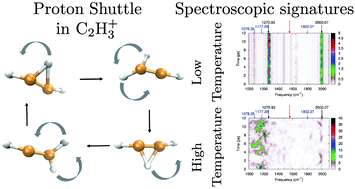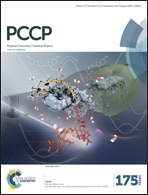A Grotthuss-like proton shuttle in the anomalous C2H3+ carbocation: energetic and vibrational properties for isotopologues†
Abstract
We probe the structure, stability and vibrational properties of the fundamental C2H3+ carbocation that exists with preference in a bridged hydrogen conformation. Our computational study includes electronic structure treatment, incorporation of nuclear motion through classical and quantum paradigms, the effect of temperature, and the associated sampling of the potential surface, and the effect of single H/D isotopic substitution (i.e., C2H2D+). We find that while the non-classical, “Bridged” isomer is most stable, the “Classical” form does have a small presence under ambient conditions since the zero point level straddles the barrier between the Classical and Bridged isomers in a reduced dimensional analysis of the Bridged ↔ Classical transfer coordinate. But the probability of the classical structure is too low and hence may remain undetected from the vibrational properties of the system. For the deuterated counterpart, the deuterium preferentially occupies the terminal instead of bridge position, in the more stable bridged isomeric structure. This preference is noted from nuclear dynamics. In all cases, at higher temperatures, an orbiting phenomenon is observed where the hydrogen atom density is distributed as an oblate ellipsoid surrounding the carbon–carbon bond. This is not observed at lower temperatures and the orbiting phenomenon is probed here by computing two-dimensional, time–frequency vibrational spectra, which show the spectral evolution in time and temperature, and the development of the system from one kind of isomer to another. New experiments that may probe this isomeric multiplicity are suggested, and these involve a combination of infra-red multiple photon dissociation (IRMPD) and argon-tagged action spectroscopy.


 Please wait while we load your content...
Please wait while we load your content...